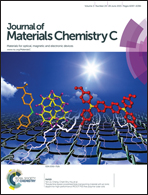Blue phosphorescent organic light-emitting devices based on carbazole/thioxanthene-S,S-dioxide with a high glass transition temperature
Abstract
Carbazole/thioxanthene-S,S-dioxide (EBCz-ThX) bipolar molecules were synthesized by incorporating electron-donating carbazole and electron-accepting thioxanthene-S,S-dioxide into one molecule at 85 °C using a solventless green reaction method. The EBCz-ThX bipolar molecule exhibited a high glass transition temperature of 227 °C and a high triplet energy of 2.94 eV. The highest occupied molecular orbital (HOMO, −5.95 eV) and lowest unoccupied molecular orbital (LUMO, −2.63 eV) energy levels of the molecule matched the HOMO energy level of the hole transporting layer and the LUMO energy level of the electron transporting layer, respectively, which facilitated the injection of holes and electrons. Phosphorescent organic light-emitting devices (PHOLEDs) were fabricated with EBCz-ThX as a blue host material and with bis((4,6-difluorophenyl)-pyridinate-N,C2′)picolinate as a blue dopant, and the doping ratio was controlled to optimize the performance of the blue PHOLEDs. Blue PHOLEDs with a 15% doping ratio at 100 cd m−2 showed excellent performances and low operation voltages with quantum and current efficiencies of about 12% and 24 cd A−1, indicating that the EBCz-ThX acted as an excellent host for the blue PHOLEDs. The external quantum efficiency at 1000 cd m−2 was improved up to 30% in comparison with that of a conventional PHOLED with an mCP of 8% doping ratio.


 Please wait while we load your content...
Please wait while we load your content...